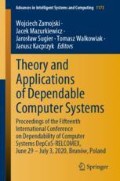Abstract
The aim of the paper is the presentation of the modification of the classical discriminant analysis. This proposal is connected with the occurrence of the spatial autocorrelation described by the spatial weights matrix, representing non-measurable spatial relationships between discriminated objects. In the model of spatial discriminant analysis there are non-spatial parameters for diagnostic variables and spatial parameters for the additional variables calculated as the product of spatial weights matrix and diagnostic variables. Such approach is an alternative solution to existing methods based on correction of a priori or a posteriori probabilities. The empirical verification of the proposed method was conducted for 114 gminas of Zachodniopomorskie voivodship in three years. The results obtained confirmed the improvement of the classification quality in case of spatial discriminant analysis in comparison to classical discriminant analysis.
Access this chapter
Tax calculation will be finalised at checkout
Purchases are for personal use only
References
Abreu, M., de Groot, H.L.F., Florax, R.J.G.M.: Space and growth: a survey of empirical ev-idence and methods. Tinbergen Institute Discussion Paper TI 2004-129/3, Amsterdam (2004)
Adamowicz, M., Pyra, M.: Links between the level of local and regional development – problems of measuring. In: Proceedings of the 2019 International Conference “Economic Science for Rural Development” No 51, Jelgava, LLU ESAF, 9–10 May 2019, pp. 14–22 (2019). https://doi.org/10.22616/esrd.2019.0522019
Anselin, L.: Spatial Econometrics: Methods and Models. Kluwer Academic, Dordrecht (1988)
Batóg, J., Batóg, B.: The application of discriminant analysis to the identification of key factors of the development of Polish cities. Folia Oeconomica. Acta Universitatis Lodziensis 4(343), 181–194 (2019). https://doi.org/10.18778/0208-6018.343.11
Churski, P.: Obszary wzrostu i obszary stagnacji gospodarczej – kontekst teoretyczny (Areas of Economic Growth and Stagnation – Theoretical Context). In: Churski, P. (ed.) Zróżnicowanie regionalne w Polsce (Regional Differences in Poland). Biuletyn Komitetu Przestrzennego Zagospodarowania Kraju, Polska Akademia Nauk, vol. 248, pp. 9–43 (2011)
Cutillo, L., Amato, U.: Localized empirical discriminant analysis. Comput. Stat. Data Anal. 52(11), 4966–4978 (2008)
Dyjach, K.: Teorie rozwoju regionalnego wobec zróżnicowań międzyregionalnych (Theories of the Regional Development in View of Interregional Disparities). Annales Universitatis Mariae Curie-Skłodowska. Sectio H Oeconomica 47(1), 49–59 (2013)
El-Hanjouri, M.M.R., Hamad, B.S.: Using cluster analysis and discriminant analysis methods in classification with application on standard of living family in Palestinian areas. Int. J. Stat. Appl. 5(5), 213–222 (2015). https://doi.org/10.5923/j.statistics.20150505.05
Fischer, M.M., Stirböck, C.: Pan-European regional income growth and club-convergence. Insights from a spatial econometric perspective. Ann. Reg. Sci. 40(4), 693–721 (2006)
Ikeda, S., Tamaki, T., Nakamura, H., Managi, S.: Inclusive wealth of regions: the case of Japan. Sustain. Sci. 12(5), 991–1006 (2017). https://doi.org/10.1007/s11625-017-0450-4
Jaba, E., Jemna, D.V., Viorica, D., Lacatusu, T.: Discriminant analysis in the study of Romanian regional economic development in view of European integration (2006). https://papers.ssrn.com/sol3/papers.cfm?abstract_id=931613
Kopczewska, K.: Ekonometria i statystyka przestrzenna z wykorzystaniem programu R CRAN (Econometrics and Statistics with R CRAN). CeDeWu, Warszawa (2006)
LeSage, J.P.: Spatial Econometrics. University of Toledo, Toledo (1999)
Malina, A.: Wielowymiarowa analiza przestrzennego zróżnicowania struktury gospodarki Polski według województw (A Multi-dimensional Analysis of the Spatial Differentiation of Poland’s Economic Structure by Voivodship). Wydawnictwo Akademii Ekonomicznej w Krakowie, Kraków (2004)
McLachlan, G.J.: Discriminant Analysis and Statistical Pattern Recognition. Wiley, Hoboken (2004)
Nigohosyan, D., Vutsova, A.: The 2014–2020 European regional development fund indicators: the incomplete evolution. Soc. Indic. Res. 137(2), 559–577 (2018). https://doi.org/10.1007/s11205-017-1610-8
Piasecki, K., Wójcicka-Wójtowicz, A.: Capacity of neural networks and discriminant analysis in classifying potential debtors. Folia Oeconomica Stetinensia 17(2), 129–143 (2017). https://doi.org/10.1515/foli-2017-0023
Qiu, W., Meng, F., Wang, Y., Fu, G., He, J., Savic, D., Zhao, H.: Assessing spatial and tem-poral variations in regional sustainability in Mainland China from 2004 to 2014. Clean Technol. Environ. Policy 20(6), 1185–1194 (2018). https://doi.org/10.1007/s10098-018-1540-4
Rezende, J.F.D.C., de Sinay, M.C.F.: Methodology for Leading Indicators on Sustainable Regional Development. Revista de Administração Pública 50(3), 395–423 (2016). https://doi.org/10.1590/0034-7612134163
Silva, R., Ferreira-Lopes, A.: A regional development index for Portugal. Soc. Indic. Res. 118(3), 1055–1085 (2014). https://doi.org/10.1007/s11205-013-0455-z
Steele, B.M., Redmond, R.L.: A method of exploiting spatial information for improving classification rules: application to the construction of polygon-based land cover maps. Int. J. Remote Sens. 22(16), 3143–3166 (2001)
Strategia Rozwoju Kraju: Strategy of National Development 2020. Ministerstwo Rozwoju Regionalnego, Warszawa (2012)
Tacq, J.: Multivariate Analysis in Social Science Research. Sage Publications, London (2007)
Todtling, F., Trippl, M.: One size fits all? Towards a differentiated regional innovation policy approach. Res. Policy 34(8), 1203–1219 (2005)
Author information
Authors and Affiliations
Corresponding author
Editor information
Editors and Affiliations
Rights and permissions
Copyright information
© 2020 The Editor(s) (if applicable) and The Author(s), under exclusive license to Springer Nature Switzerland AG
About this paper
Cite this paper
Batóg, J., Batóg, B. (2020). Classification of Local Administrative Units in Poland: Spatial Approach. In: Zamojski, W., Mazurkiewicz, J., Sugier, J., Walkowiak, T., Kacprzyk, J. (eds) Theory and Applications of Dependable Computer Systems. DepCoS-RELCOMEX 2020. Advances in Intelligent Systems and Computing, vol 1173. Springer, Cham. https://doi.org/10.1007/978-3-030-48256-5_4
Download citation
DOI: https://doi.org/10.1007/978-3-030-48256-5_4
Published:
Publisher Name: Springer, Cham
Print ISBN: 978-3-030-48255-8
Online ISBN: 978-3-030-48256-5
eBook Packages: Intelligent Technologies and RoboticsIntelligent Technologies and Robotics (R0)

